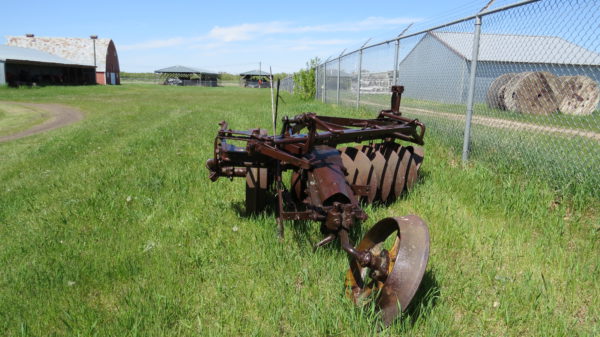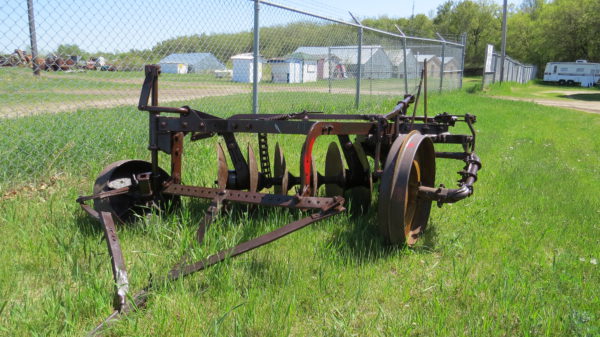
Along with moldboard plows, the Cockshutt Plow Company Limited also built disc plows. Disc plows are suitable for the very sticky soils found in many areas. These soils pose problems for moldboard plows. Cockshutt built both horse drawn disc plows and tractor drawn disc plows which ranged in size from one disc to five discs. Along with Cockshutt built plows, Cockshutt also sold the Angell Disc Plow from the Ohio Cultivator Company which came in 6 ft, 8 ft and 10 ft sizes with 20 inch discs. Selling the Angell allowed Cockshutt to offer a more complete line of tillage equipment with a minimum investment. From the Ohio Cultivator Company point of view, an arrangement with Cockshutt increased sales in Canada, an area where the company had no presence, and all at a low cost to Ohio.

However, in 1931, Cockshutt took the Angell concept and made a huge leap forward. Cockshutt designed their version of the Angell making a number of improvements along with one important innovation, that of mounting a seed box on the machine. This machine they called a tiller combine.

The Cockshutt Tiller Combine featured disc blades mounted 7 1/2 inches apart. The disc blades were 24 inches in diameter which was a smaller disc than the 30 blades featured on Cockshutt disc plows. All blades were mounted on a single shaft, raised and lowered by a power lift. The shaft was supported on ball bearings, so the entire assembly (shaft and blades) rotated. The depth of penetration of the soil by the blades could be adjusted. When seeding, the seed box dropped the seed down tubes which ran immediately in front of the shaft, and close to the back of each blade. Each blade had its own tube. As the seed was dropped, the blade following behind threw dirt over the seed.
For 1931, the Cockshutt Tiller Combine was a revolutionary concept as the machine was a combined plow, light disc and seeder. Only one field operation was necessary, that of seeding the land in the spring. Fall plowing was not necessary, which saved time, money and even more importantly, conserved moisture and reduced soil erosion as the stubble was left on the field to trap snow and slow down the wind at the surface of the soil. When seeding, the combine tiller left a rough surface which aided in reducing wind erosion. The tiller combine did not pulverize the soil, which also aided in reducing soil erosion. Given the drought conditions of the 1930s, the Cockshutt Tiller Combine was the right machine at the right time.

The Cockshutt Tiller Combine was available in 3.5 ft and 4 ft sizes, suitable for horse traction. The Tiller Combine was also produced in 6 ft, 8 ft and 10 ft sizes suitable for various sizes of tractors.
In 1931, Cockshutt sold 100 units. While this number is small, one must remember the conditions experienced in 1931 of a widespread and serious drought, a collapse in farm prices and a sever economic recession. 100 units in this context was a significant achievement which indicates the concept behind the Tiller Combine was a solid one, that farmers saw value in. Further proof that the concept was a good one was the copying of the Cockshutt Tiller Combine by other farm equipment manufacturers in the years after 1931.
The MAM collection includes several Cockshutt Tiller Combines including one set up for horse operation with an operator’s seat on the machine. The collection also includes a Cockshutt Tiller Combine painted Canadian Co-operative Implements Limited Orange and sold through CCIL. This machine was built sometime after mid-1945.
Cockshutt wanted to increase sales in 1945, which meant it had to get into the US market. Cockshutt and the US-based National Farm Machinery Co-operative (NFMC) came to an agreement where Cockshutt implements were sold through NFMC outlets across 11 states. Frost and Woods (a subsidiary of Cockshutt) which made haying and harvesting equipment, was also included in this deal. The deal with NFMC allowed Cockshutt into 11 states where Cockshutt had no previous presence, and all at a low cost.
However, to get the deal with NFMC, Cockshutt also had to agree to supply equipment to Canadian Co-operative Implements Limited (CCIL). Cockshutt was not in favor of supplying equipment to CCIL, as CCIL would be in competition for sales of equipment with Cockshutt operations in Western Canada. However, the NFMC was adamant that CCIL was to be included. The deciding factor was that both Co-ops agreed to take a large amount of equipment and would pay for this equipment in advance. As Cockshutt at the time was in the process of developing its own tractor line and expanding its combine line, this money was needed by Cockshutt. And so Cockshutt agreed to supply NFMC and CCIL. Cockshutt painted the equipment supplied to both co-ops in each of the co-op’s color schemes. The orange used by CCIL was different in shade than the orange used by NFMC.


